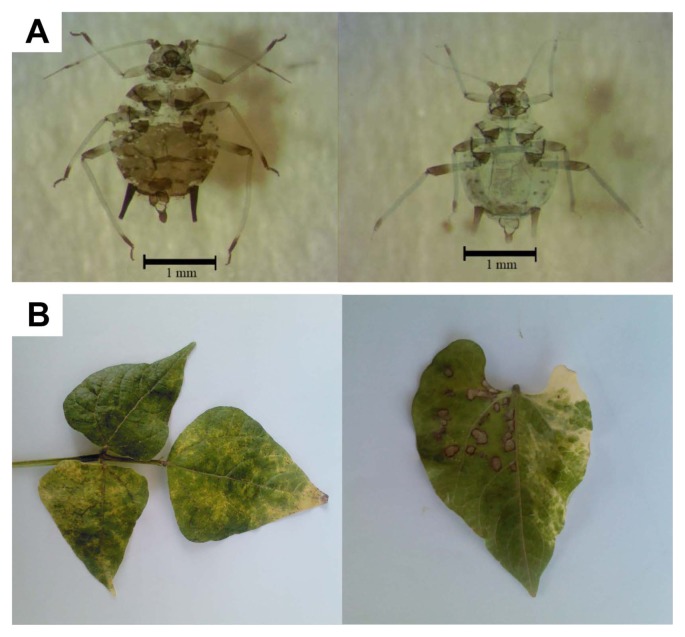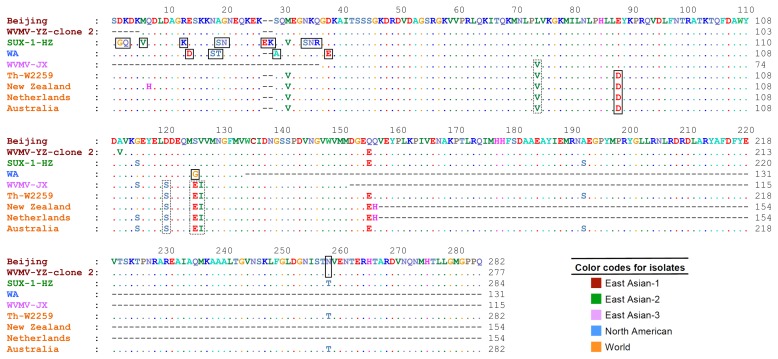Altschul, SF, Madden, TL, Schäffer, AA, Zhang, J, Zhang, Z, Miller, W and Lipman, DJ 1997. Gapped BLAST and PSI-BLAST: a new generation of protein database search programs.
Nucleic Acids Res. 25:3389-3402.



Atoni, E, Wang, Y, Karungu, S, Waruhiu, C, Zohaib, A, Obanda, V, Agwanda, B, Mutua, M, Xia, H and Yuan, Z 2018. Metagenomic virome analysis of Culex mosquitoes from Kenya and China.
Viruses. 10:30



Bos, L 1996. Wisteria vein mosaic potyvirus. In: Viruses of plants: descriptions and lists from the VIDE Database, eds. by AA Brunt, K Crabtree, MJ Dallwitz, AJ Gibbs and L Watson, 1407-1409. CAB International, Wallingford, UK.
Brunt, AA, Crabtree, K, Dallwitz, MJ, Gibbs, AJ and Watson, L 1996. Viruses of plants: descriptions and lists from the VIDE Database. CAB International, Wallingford, UK. 1504.
Clover, GRG, Denton, JO and Denton, GJ 2015. First report of Wisteria vein mosaic virus on Wisteria spp. in the United Kingdom.
New Dis Rep. 31:1

Clover, GRG, Tang, Z, Smales, TE and Pearson, MN 2003. Taxonomy of Wisteria vein mosaic virus and extensions to its host range and geographical distribution.
Plant Pathol. 52:92-96.

de Fátima Rosas-Cárdenas, F, Durán-Figueroa, N, Vielle-Calzada, J-P, Cruz-Hernández, A, Marsch-Martínez, N and de Folter, S 2011. A simple and efficient method for isolating small RNAs from different plant species.
Plant Methods. 7:4



Donaldson, EF, Haskew, AN, Gates, JE, Huynh, J, Moore, CJ and Frieman, MB 2010. Metagenomic analysis of the viromes of three North American bat species: viral diversity among different bat species that share a common habitat.
J Virol. 84:13004-13018.



Esfandiari, N, Kohi-Habibi, M and Mosahebi, G 2006. Occurrence of viruses infecting pea in Iran.
Commun Agric Appl Biol Sci. 71:1281-1287.

Farzadfar, S, Golnaraghi, AR and Pourrahim, R 2002. Plant viruses of Iran. Saman Company, Tehran, Iran. 203.
Farzadfar, S, Tomitaka, Y, Ikematsu, M, Golnaraghi, AR, Pourrahim, R and Ohshima, K 2009. Molecular characterisation of Turnip mosaic virus isolates from Brassicaceae weeds.
Eur J Plant Pathol. 124:45-55.

Feng, Y, Krueger, EN, Liu, S, Dorman, K, Bonning, BC and Miller, WA 2017. Discovery of known and novel viral genomes in soybean aphid by deep sequencing.
Phytobiomes. 1:36-45.

Fereres, A and Raccah, B 2015 Plant virus transmission by insects. URL . 29 October 2019.
Foottit, RG, Maw, HEL, Von Dohlen, CD and Hebert, PDN 2008. Species identification of aphids (Insecta: Hemiptera: Aphididae) through DNA barcodes.
Mol Ecol Resour. 8:1189-1201.


Golnaraghi, A, Shahraeen, N and Nguyen, HD 2018. Characterization and genetic structure of a Tospovirus causing chlorotic ring spots and chlorosis disease on peanut; comparison with Iranian and Polish populations of Tomato yellow fruit ring virus.
Plant Dis. 102:1509-1519.


Golnaraghi, AR, Shahraeen, N, Pourrahim, R, Farzadfar, S and Ghasemi, A 2004. Occurrence and relative incidence of viruses infecting soybeans in Iran.
Plant Dis. 88:1069-1074.


Guerrieri, E and Digilio, MC 2008. Aphid-plant interactions: a review.
J Plant Interact. 3:223-232.

Ha, C, Coombs, S, Revill, PA, Harding, RM, Vu, M and Dale, JL 2008. Design and application of two novel degenerate primer pairs for the detection and complete genomic characterization of potyviruses.
Arch Virol. 153:25-36.


Hall, TA 1999. BioEdit: a user-friendly biological sequence alignment editor and analysis program for Windows 95/98/NT. Nucleic Acids Symp Ser. 41:95-98.
Harrington, R, Katis, N and Gibson, RW 1986. Field assessment of the relative importance of different aphid species in the transmission of potato virus Y.
Potato Res. 29:67-76.

Hashemi, S 2015. Distribution model of aphid species as vectors of potyviruses of legumes in climates of Iran with an emphasis on the climates of Markazi province. MSc thesis. Science and Research Branch, Islamic Azad University, Tehran, Iran.
Hull, R 2014. Plant virology. 5th ed. Academic Press, Amsterdam, Netherlands. 1104.
Islam, W, Lin, W, Islam, SU, Arif, M, Li, X, Yang, Y, Ding, X, Du, Z and Wu, Z 2018. Genetic diversity of begomoviruses in Pakistan captured through a vector based survey.
Microb Pathogen. 118:91-97.

Ji, Z-L, Zhu, P-X, Ji, Y-H, Xu, F and Zhu, F 2019. First report of wisteria vein mosaic virus in Chinese wisteria in Jiangxi Province in China.
J Plant Pathol. 101:1259-1260.

Jo, Y, Lian, S, Chu, H, Cho, JK, Yoo, S-H, Choi, H, Yoon, J-Y, Choi, S-K, Lee, BC and Cho, WK 2018. Peach RNA viromes in six different peach cultivars.
Sci Rep. 8:1844.

Jones, DR 2005. Plant viruses transmitted by thrips.
Eur J Plant Pathol. 113:119-157.

Jones, S, Baizan-Edge, A, MacFarlane, S and Torrance, L 2017. Viral diagnostics in plants using next generation sequencing: computational analysis in practice.
Front Plant Sci. 8:1770



Kaiser, WJ, Danesh, D, Okhovat, M and Mossahebi, H 1968. Diseases of pulse crops (edible legumes) in Iran. Plant Dis Rep. 52:687-689.
Kamińska, M, Malinowski, T, Rudzińska-Langwald, A and Diaz, LC 2006. The occurrence of Wisteria vein mosaic virus in Wisteria floribunda DC plants in Poland.
J Phytopathol. 154:414-417.

Letunic, I and Bork, P 2019. Interactive tree of life (iTOL) v4: recent updates and new developments.
Nucleic Acids Res. 47:W256-W259.



Li, J, Jiang, J-H, Fu, C-X and Tang, S-Q 2014. Molecular systematics and biogeography of Wisteria inferred from nucleotide sequences of nuclear and plastid genes.
J Syst Evol. 52:40-50.

Li, L, Victoria, JG, Wang, C, Jones, M, Fellers, GM, Kunz, TH and Delwart, E 2010. Bat guano virome: predominance of dietary viruses from insects and plants plus novel mammalian viruses.
J Virol. 84:6955-6965.



Liang, WX, Song, LM, Li, Y, Tian, GZ, Li, HF and Fan, ZF 2004. First report of Wisteria vein mosaic virus in China.
Plant Pathol. 53:516

Liang, WX, Song, LM, Tian, GZ, Li, HF and Fan, ZF 2006. The genomic sequence of Wisteria vein mosaic virus and its similarities with other potyviruses.
Arch Virol. 151:2311-2319.


Liu, S, Vijayendran, D, Chen, Y and Bonning, B 2016. Aphis glycines virus 2, a novel insect virus with a unique genome structure.
Viruses. 8:315



MacDiarmid, R, Rodoni, B, Melcher, U, Ochoa-Corona, F and Roossinck, M 2013. Biosecurity implications of new technology and discovery in plant virus research.
PLoS Pathog. 9:e1003337



Martin, DP, Murrell, B, Golden, M, Khoosal, A and Muhire, B 2015. RDP4: detection and analysis of recombination patterns in virus genomes.
Virus Evol. 1:vev003



Moury, B, Fabre, F and Senoussi, R 2007. Estimation of the number of virus particles transmitted by an insect vector.
Proc Natl Acad Sci U S A. 104:17891-17896.



Mowat, WP and Dawson, S 1987. Detection and identification of plant viruses by ELISA using crude sap extracts and unfractionated antisera.
J Virol Methods. 15:233-247.


Mozaffarian, V 2013. Identification of medicinal and aromatic plants of Iran. Farhang Moaser Publishers, Tehran, Iran. 1350.
Mumford, R, Boonham, N, Tomlinson, J and Barker, I 2006. Advances in molecular phytodiagnostics: new solutions for old problems.
Eur J Plant Pathol. 116:1-19.



Naidu, RA and Karthikeyan, G 2008. First report of Wisteria vein mosaic virus in Wisteria sinensis in the United States of America.
Plant Health Prog. 9:42

Ong, JWL, Li, H, Sivasithamparam, K, Dixon, KW, Jones, MGK and Wylie, SJ 2017. The challenges of using high-throughput sequencing to track multiple bipartite mycoviruses of wild orchid-fungus partnerships over consecutive years.
Virology. 510:297-304.


Paez-Espino, D, Eloe-Fadrosh, EA, Pavlopoulos, GA, Thomas, AD, Huntemann, M, Mikhailova, N, Rubin, E, Ivanova, NN and Kyrpides, NC 2016. Uncovering Earth’s virome.
Nature. 536:425-430.


Pappu, SS, Brand, R, Pappu, HR, Rybicki, EP, Gough, KH, Frenkel, MJ and Niblett, CL 1993. A polymerase chain reaction method adapted for selective amplification and cloning of 3′ sequences of potyviral genomes: application to dasheen mosaic virus.
J Virol Methods. 41:9-20.


Pettersson, JH-O, Shi, M, Bohlin, J, Eldholm, V, Brynildsrud, OB, Paulsen, KM, Andreassen, A and Holmes, EC 2017. Characterizing the virome of Ixodes ricinus ticks from northern Europe.
Sci Rep. 7:10870



Posada, D 2002. Evaluation of methods for detecting recombination from DNA sequences: empirical data.
Mol Biol Evol. 19:708-717.


Roossinck, MJ 2012. Plant virus metagenomics: biodiversity and ecology.
Annu Rev Genet. 46:359-369.


Schrader, C, Schielke, A, Ellerbroek, L and Johne, R 2012. PCR inhibitors - occurrence, properties and removal.
J Appl Microbiol. 113:1014-1026.


Shahraeen, N, Ghotbi, T, Elkhache, AD and Sahandi, A 2005. A survey of viruses affecting French bean (Phaseolus vulgaris) in Iran includes a first report of Southern bean mosaic virus and Bean pod mottle virus.
Plant Dis. 89:1012

Tamura, K, Stecher, G, Peterson, D, Filipski, A and Kumar, S 2013. MEGA6: molecular evolutionary genetics analysis version 6.0.
Mol Biol Evol. 30:2725-2729.



Valouzi, H, Golnaraghi, A, Abedini-Aminabad, L and Diyanat, M 2017. Serological and molecular identification of Turnip mosaic virus in some wild plants in Iran.
Australas Plant Dis Notes. 12:3

Virgin, HW 2014. The virome in mammalian physiology and disease.
Cell. 157:142-150.



Wamonje, FO, Michuki, GN, Braidwood, LA, Njuguna, JN, Musembi Mutuku, J, Djikeng, A, Harvey, JJW and Carr, J 2017. Viral metagenomics of aphids present in bean and maize plots on mixed-use farms in Kenya reveals the presence of three dicistroviruses including a novel Big Sioux River virus-like dicistrovirus.
Virol J. 14:188



Ward, LI, Tang, JZ and Clover, GRG 2008. First report of Wisteria vein mosaic virus on Wisteria sinensis in New Zealand.
Plant Dis. 92:1134

Wegley, L, Edwards, R, Rodriguez-Brito, B, Liu, H and Rohwer, F 2007. Metagenomic analysis of the microbial community associated with the coral Porites astreoides.
Environ Microbiol. 9:2707-2719.


Whitfield, AE, Falk, BW and Rotenberg, D 2015. Insect vector-mediated transmission of plant viruses.
Virology. 479-480:278-289.

Wylie, SJ, Adams, M, Chalam, C, Kreuze, J, López-Moya, JJ, Ohshima, K, Praveen, S, Rabenstein, F, Stenger, D, Wang, A and Zerbini, FM ICTV Report Consortium. 2017. ICTV Virus Taxonomy Profile: Potyviridae.
J Gen Virol. 98:352-354.



Wylie, SJ and Jones, MGK 2012. Complete genome sequences of seven carlavirus and potyvirus isolates from Narcissus and Hippeastrum plants in Australia, and proposals to clarify their naming.
Arch Virol. 157:1471-1480.


Wylie, SJ, Li, H, Dixon, KW, Richards, H and Jones, MGK 2013. Exotic and indigenous viruses infect wild populations and captive collections of temperate terrestrial orchids (Diuris species) in Australia.
Virus Res. 171:22-32.


Wylie, SJ, Li, H, Saqib, M and Jones, MGK 2014. The global trade in fresh produce and the vagility of plant viruses: a case study in garlic.
PLoS ONE. 9:e105044



Wylie, SJ, Luo, H, Li, H and Jones, MGK 2012. Multiple polyadenylated RNA viruses detected in pooled cultivated and wild plant samples.
Arch Virol. 157:271-284.


Yasaka, R, Fukagawa, H, Ikematsu, M, Soda, H, Korkmaz, S, Golnaraghi, A, Katis, N, Ho, SYW, Gibbs, AJ and Ohshima, K 2017. The timescale of emergence and spread of Turnip mosaic Potyvirus.
Sci Rep. 7:4240



Zheng, L, Rodoni, BC, Gibbs, MJ and Gibbs, AJ 2010. A novel pair of universal primers for the detection of potyviruses.
Plant Pathol. 59:211-220.










 PDF Links
PDF Links PubReader
PubReader Full text via DOI
Full text via DOI Full text via PMC
Full text via PMC Download Citation
Download Citation Supplement
Supplement Print
Print




